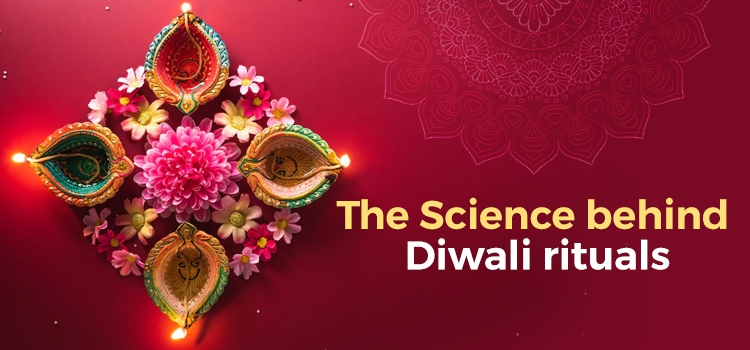The Science behind Diwali rituals
India celebrates many festivals. Being a country that is home to people who practice many faiths, this is not surprising. Hindus, especially, celebrate festivals throughout the year. They celebrate the birth of various gods and goddesses, their weddings, and their victories over the forces of evil, which ensures that almost every month, they have something or the other to celebrate.
The distinct heritage and customs of Indians are evident in the lively festivals. These festivals also bring together people of all religions and castes. It is quite common to find Muslims taking part in Durga Pooja and Vinayaka Chaturthi celebrations, for instance. Sometimes, the idols of the Hindu deities are made by Muslim artisans who have been doing it for generations.

Diwali: The Festival of Lights
If there is a poll to determine the most popular festival in India, Diwali will win hands down. It is also called Deepavali, or the festival of lights, and is celebrated all over India.
Diwali is a 5-day festival. It begins with Dhanteras and ends with Bhai Dooj. In between the two come Narak Chaturdashi or Chhoti Diwali, Lakshmi Pooja or Badi Diwali, and Govardhan Pooja in that order. The festival falls in the Hindu month of Kartik (Oct-Nov).
Deep means ‘light’, and ‘vali’ means ‘row’. Rows of lights in the form of clay lamps or diyas illuminate people’s houses during Diwali, signifying the arrival of light and the end of darkness. In some parts of India, it also marks the New Year.
Why is Diwali Celebrated?
Many legends explain the rationale for the Diwali festival. Some relate it to Lord Rama’s return from exile to Ayodhya after killing the demon Ravana. Others relate it to the killing of Narakasura by Lord Krishna. It is also held to be the birthday of Goddess Lakshmi, who emerged from the Milky Ocean on this day during Samudra Manthan. The festival is also important for Jains and Sikhs. There is a belief that Diwali also began as a harvest festival, which celebrates the year’s final harvest before the onset of winter.
It was on Diwali that the legendary Hindu king, Vikramaditya, ascended the throne. He was a model king who was known for his valor, acts of charity, and patronage of intellectuals. Jains believe that Mahavira, the 24th and last Jain Tirthankara, attained Nirvana on this day. It happened on Chaturdashi of Kartik month.
The Science behind Diwali Rituals
Astronomy plays a part in Diwali. Diwali occurs on different days each year, unlike Christmas, which always falls on the same day. Hindus tend to use the lunar calendar for their celebrations. Which means that the Moon has a lot to do with these festivals. While Diwali is based on the lunar calendar, other festivals follow the solar calendar. That is, they depend on the Sun. So, with the exception of leap years, they will be celebrated on the same date every year.
There is no Diwali without fireworks. Children especially love fireworks. The sounds and colors, and sparkles excite them. But there is also a scientific reason for lighting fireworks for Diwali. Diwali falls in October or November usually. This is also the time of the north-east monsoon. In some places, there is always rain on the day before Diwali. When pools of water stagnate, it is ideal for mosquitoes to breed. It is a well-known fact that mosquitoes spread many dangerous diseases like malaria, dengue, etc.
When there was an outbreak of dengue fever in Delhi, scientists and health officials requested people to burst crackers and fireworks to deal with the mosquito problem. Bursting firecrackers and the resulting light and noise, according to Diwali lore, scare evil spirits that are present around us. In a sense, the mosquitoes which spread diseases are also ‘evil spirits’.
Most people use earthen diyas to light up their houses during Diwali. The earthen material makes the diyas burn longer and also distributes the light and warmth better.
On the morning of Diwali, the first ritual was to take a bath with Ganges water and various oils. This is Abhyanga Snanam. It is good for broken skin, enables weight loss, and can even delay the aging process.
Diwali is when people spring clean their homes thoroughly. They also light hundreds of lamps to illuminate the surroundings, which creates a feeling of safety. The surface electromagnetic flux is surrounded by light from the diyas that is superimposed on the magnetic field.
In modern times, some people tend to believe that age-old customs and rituals of our festivals are outdated and need to be abandoned. But the fact is that they are often rooted in science. For instance, during some festivals, people have to observe fast. They avoid certain foods like non-veg, and they also consume certain foods during the festival. This helps detoxify the body and also prevents illness. During the rainy season especially, eating non-veg food, which takes time to digest, can cause health problems. Also, contaminated water can cause diseases at this time. For festivals that fall in summer, light food is recommended for the same reason.
Diwali 2022 is from Oct 22 to Oct 27. Diwali Pooja 2022, or Lakshmi Pooja, is on Oct 24.




















